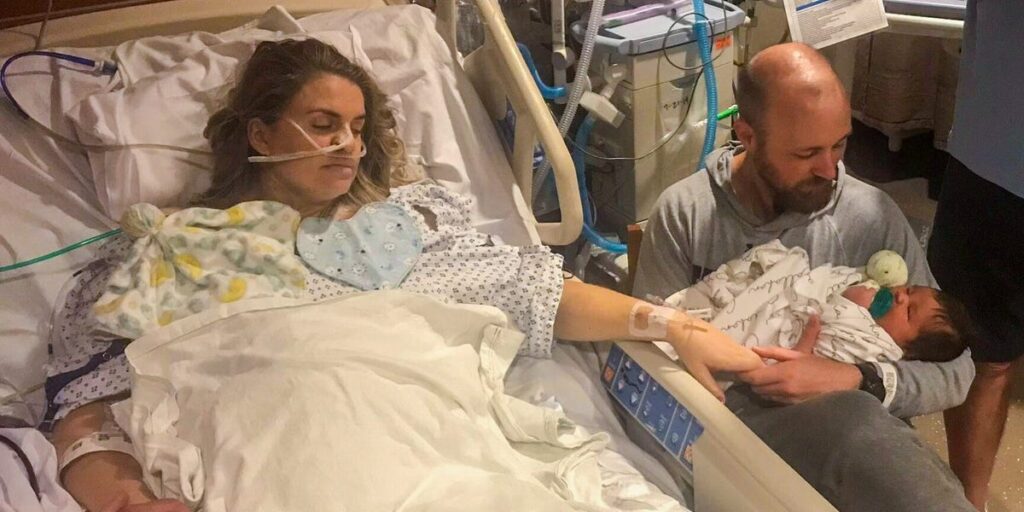- Kayleigh Summers, 34, had an amniotic fluid embolism that caused heart and lung failure.
- Her baby was born via emergency cesarean six minutes after she lost consciousness.
- She was in the hospital for two weeks, but needed years to process the trauma.
This as-told-to essay is based on a conversation with Kayleigh Summers, founder of The Birth Trauma Mama. It has been edited for length and clarity.
I don’t remember anything about giving birth to my son, Callahan. But by talking with my husband and my doctors, and pouring over more than 6,000 pages of medical records, I pieced together that day, when I nearly died.
Callahan was my first baby, and at 40 weeks and two days I was induced because my blood pressure was high. It was a normal, slow induction for a first time mom, but after two and a half days I was finally ready to push.
I told the nurse I didn’t feel well, and she thought it was the normal nausea that comes during transition. That’s when I started screaming that something was wrong with my heart. A few seconds later, I passed out. My heart wasn’t beating and I had stopped breathing.
The doctors rushed me to the operating room. Callahan was born just six minutes after the code was called. That speed likely saved both our lives.
Callahan was quickly resuscitated, but my heart stopped again
While doctors were delivering Callahan, another team was working on me. I was still unresponsive. Callahan was born not breathing, but he quickly came to. Doctors told my family, “the baby is fine, but Kayleigh isn’t.”
Doctors restarted my heart, but it stopped again. My OB/GYN recognized that I was having an amniotic fluid embolism, an allergic-like reaction that happens when amniotic fluid enters a mothers’ blood stream. It leads to heart and lung failure, and massive bleeding. I needed 143 units of blood.
I was put on life support, then transferred to another hospital. There, the doctor said he was going to try one last ditch effort to save me — an Impella heart pump. Luckily, it worked so well that within 24 hours I was able to start coming off life support.
My brain erased memories of pregnancy and birth
I met Callahan for the first time when he was five days old. My first thought was “this isn’t my baby.”
My brain just couldn’t process all that had happened. Callahan was born Wednesday afternoon. The last memory I have is of getting my nails done the Friday before. When I first woke up, I had no memory of any prenatal appointments. It was like my brain had tried to erase anything that had to do with pregnancy or birth. Medically, the amnesia didn’t make sense, but I’m a trauma therapist, and I understood that my brain was trying to protect me.
In recovery, I felt torn between my personal and professional responses to the birth. Many, many people who have an amniotic fluid embolism don’t survive, and I was just so happy to be alive. On the other hand, as a mental health professional I knew recovering was going to be really, really difficult. In the hospital I told my husband and other family members they were all getting therapy to deal with their trauma (and they have).
I struggled to bond with my son
I was discharged from the hospital when Callahan was two weeks old. I was so mentally and physically exhausted that I wasn’t interested in the baby. My family members would ask if I wanted to feed him, and I’d say yes, because I felt I had to. Then, I would hate every minute of it.
Looking back, I can see that taking those feedings was bonding. But it was so different from the postpartum I’d envisioned that it caused a lot of emotional pain at the time.
I started sharing my story about six months after Callahan’s birth. Today, I specialize in treating perinatal trauma. Not all trauma looks like mine, but all birth trauma can have an impact on parenting. I wanted to create a community where people could talk about their feelings, without needing to make them more palatable to others.
I still grieve only having one child
Today Callahan is 5. I’m still devastated by the way he entered the world, but we talk about his birth story. In our first family picture, I’m on a ventilator, and Callahan knows I needed it to breathe.
The hardest part of my journey has been accepting that Callahan will be my only child. I had an emergency hysterectomy during his birth. Not only was I not alive when my only son was born, but I’ll never get to experience first cries or the golden hour with another baby.
That grief will live with me for the rest of my life, but I feel more at peace with it than I ever have before. I just can’t imagine my family looking any different than it does now.
Read the full article here
















